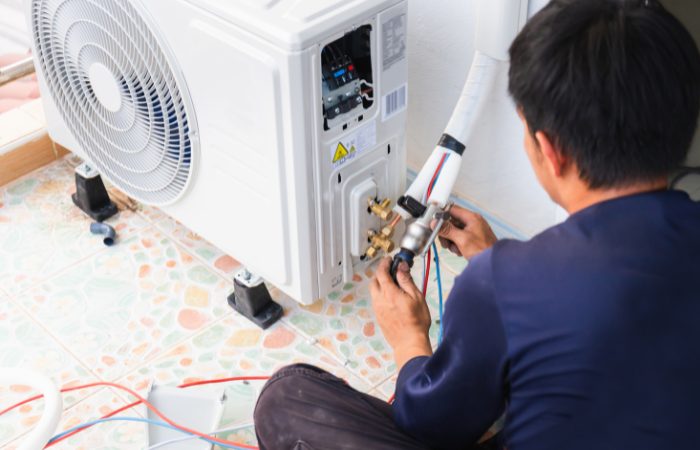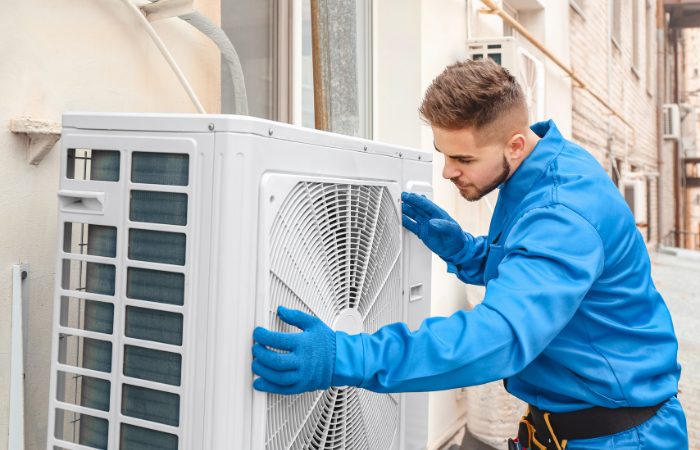Keeping your air conditioning system in top shape is crucial, especially as temperatures climb. A key component of routine AC maintenance is ensuring the drain line is clear of blockages, which can lead to water leaks and mildew growth. Regular AC coil cleaning is essential for system efficiency and complements the routine of cleaning your AC drain line. In this guide, we’ll show you how to clean an AC drain line effectively, preventing common issues and expanding the lifespan of your unit.
Whether you’re a seasoned DIYer or new to home maintenance, learning how to clean an AC drain line is an essential skill that can save you time and money while ensuring your system runs smoothly.
How to Clean an AC Drain Line
When cleaning your AC drain line, it’s essential to be thorough to prevent issues like water leaks and mold growth. This simple upkeep task can save you from costly repairs and guarantee your system runs efficiently. Here’s a step-by-step guide on how to clean an AC drain line properly, with each step detailed to help you understand the importance and the method effectively.
Step 1: Confirm Safety by Turning Off the AC Unit
Safety First: Begin by turning off your AC unit to prevent any electrical hazards while cleaning, which is essential when learning how to clean an AC drain line. This is the most vital safety measure you can take. Locate the main power breaker for the AC system and switch it off, confirming that there is no power flowing to the unit. This precaution prevents unexpected startup of the system during the cleaning process and protects you from potential electric shocks, especially when you are working with water.
Step 2: Locate and Clean the Condensation Pan
Identifying and Addressing Stagnation: Find the condensation pan, which is typically located directly under the indoor air handler. This could be in an attic or a utility closet. Stagnant water in this pan is a key indicator that the drain line is clogged. Use a shop vacuum to efficiently remove the water, or use rags if the quantity of water is minimal. After removing the water, thoroughly clean the pan with soap and warm water to remove any residual dirt, mold, or algae, ensuring the pan is completely clean.
Step 3: Access the Drain Line
Access and Inspection: Locate the access point of the drain line, which usually includes a T-shaped vent with a PVC cap that can be removed. This access point allows you to directly address and inspect any clogs or debris within the drain line. Removing the cover is crucial for providing physical access to effectively clean and clear the line. Recognizing the signs of a clogged AC drain line early can prevent more severe issues down the line.
Step 4: Vacuum the Clog
Effective Removal of Blockages: Using a shop vacuum, attach the hose to the access point of the drain line, typically found outside near the foundation of the house. The vacuum’s strong suction is designed to pull out debris, mold, and algae that are clogging the line. You can visually confirm the removal of the clog by checking the contents of the vacuum’s canister. This method is a key step in understanding how to clean an AC drain line effectively, ensuring that the system remains free from obstructions.
Step 5: Flush with Vinegar
Natural Cleaning Solution: Pour distilled vinegar down the drain line. Vinegar is a perfect natural cleaner that helps dissolve mold, algae, and other residues without damaging the pipes. For stubborn clogs, alternate this with a warm water and dish soap solution to further break down and remove debris. Let the solution sit in the drain line for about 30 minutes, letting the acidic properties of the vinegar thoroughly cleanse the line. This approach is a crucial part of learning how to clean an AC drain line effectively, ensuring it remains clear and functional.
Step 6: Rinse the Drain Line
Thorough Cleaning: After the cleaning solutions have had time to work, flush the drain line with clean water to ensure all debris and cleaning solutions are completely washed away. While cleaning the drain line, it’s also a good time to check your AC refrigerant levels to ensure optimal performance. It’s helpful to have someone at the other end of the drain line to check if the water is running freely, indicating that all blockages have been removed.
Step 7: Confirm Flow is Restored
Check for Clear Drainage: Once the line has been flushed, visually inspect the flow at the exit point of the drain line. A steady and strong flow of water means the drain is fully cleared. If the water flow is still restricted, it may be necessary to repeat the vacuuming and flushing until the line is completely unobstructed. This step is crucial in learning how to clean an AC drain line effectively, ensuring that the system functions efficiently without water backup issues.
Step 8: Reassemble and Test the System
Final Steps: After ensuring that the drain line is clear, reattach any caps or covers that were removed during the cleaning process. Restore power to the AC unit and turn it on to test its functionality. Monitor the system for a while to ensure there are no leaks and that it is operating smoothly, confirming that the cleaning process was successful.
FAQs on How to Clean an AC Drain Line

How often should I clean my AC drain line to maintain optimal performance?
Regular cleaning of your AC drain line is crucial for maintaining system efficiency. It’s recommended to clean the line at least once a year, typically before the cooling season begins. However, if you live in a humid area or use your AC heavily, consider cleaning it twice a year to prevent blockages and guarantee smooth operation.
What tools are necessary for cleaning an AC drain line effectively?
To clean your AC drain line effectively, you’ll need a few basic tools: white vinegar for flushing the line, a funnel to pour liquids into the drain, a wet/dry vacuum for removing tough clogs, and a flashlight for inspection. These tools help ensure a thorough cleaning process, keeping your system running smoothly.
How do I know if the AC drain line cleaning was successful?
After cleaning your AC drain line, check for free-flowing water through the line to ensure it’s clear. If water flows without any backup and you observe no standing water in the condensate pan, the cleaning is likely successful. The importance of regular AC maintenance and monitoring for any water leaks or mold around the drain line area can also indicate a clear, functioning line.
What should I do if I cannot clear a clog in my AC drain line by myself?
If you’ve attempted to clean your AC drain line and still notice blockages or poor drainage, it may be time to call a professional. HVAC technicians can provide a deeper clean using specialized tools and techniques to empty stubborn clogs, ensuring your system runs efficiently and decreasing the risk of damage.
Conclusion
With these steps on how to clean an AC drain line, you’re well-equipped to maintain your system and prevent common problems like leaks and mold growth. Routine cleaning not only enhances the efficiency of your air conditioner but also expands its lifespan, saving you money and hassle in the long run. If you’re faced with a clogged line, here’s a detailed guide on how to fix a clogged AC drain line effectively.
If you need professional help with your AC maintenance or repair, Tropic Air-Conditioning Inc., a heating and air conditioning in Sarasota provides reliable and expert services. Contact us today to ensure your air conditioning system is in top shape for the heat!




